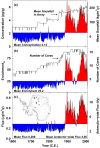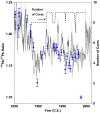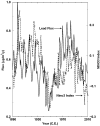Antarctic-wide array of high-resolution ice core records reveals pervasive lead pollution began in 1889 and persists today
- PMID: 25068819
- PMCID: PMC5376174
- DOI: 10.1038/srep05848
Antarctic-wide array of high-resolution ice core records reveals pervasive lead pollution began in 1889 and persists today
Abstract
Interior Antarctica is among the most remote places on Earth and was thought to be beyond the reach of human impacts when Amundsen and Scott raced to the South Pole in 1911. Here we show detailed measurements from an extensive array of 16 ice cores quantifying substantial toxic heavy metal lead pollution at South Pole and throughout Antarctica by 1889 - beating polar explorers by more than 22 years. Unlike the Arctic where lead pollution peaked in the 1970s, lead pollution in Antarctica was as high in the early 20(th) century as at any time since industrialization. The similar timing and magnitude of changes in lead deposition across Antarctica, as well as the characteristic isotopic signature of Broken Hill lead found throughout the continent, suggest that this single emission source in southern Australia was responsible for the introduction of lead pollution into Antarctica at the end of the 19(th) century and remains a significant source today. An estimated 660 t of industrial lead have been deposited over Antarctica during the past 130 years as a result of mid-latitude industrial emissions, with regional-to-global scale circulation likely modulating aerosol concentrations. Despite abatement efforts, significant lead pollution in Antarctica persists into the 21(st) century.
Conflict of interest statement
The authors declare no competing financial interests.
Figures



References
-
- McConnell J. R., Lamorey G. W. & Hutterli M. A. A 250-year high-resolution record of Pb flux and crustal enrichment in central Greenland. Geophys. Res. Lett. 29, 2130 10.1029/2002gl016016 (2002). - DOI
-
- Sangster D. F., Outridge P. M. & Davis W. J. Stable lead isotope characteristics of lead ore deposits of environmental significance. Environ. Rev. 8, 115–147, 10.1139/a00-008 (2000). - DOI
-
- Rosman K. J. R., Chisholm W., Hong S. M., Candelone J. P. & Boutron C. F. Lead from Carthaginian and Roman Spanish mines isotopically identified in Greenland ice dated from 600 BC to 300 AD. Environ. Sci. Technol. 31, 3413–3416, 10.1021/es970038k (1997). - DOI
Publication types
MeSH terms
Substances
LinkOut - more resources
Full Text Sources
Other Literature Sources
Miscellaneous

